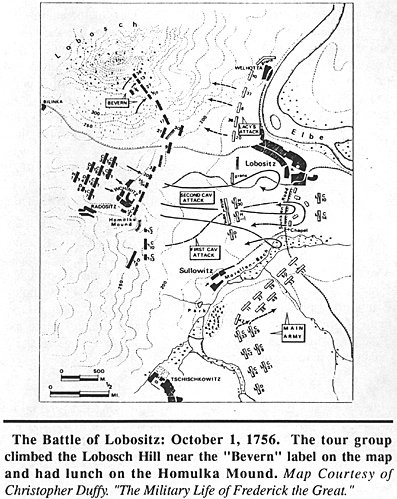 On Lobosch Hill: The Battle of Lobositz
On Lobosch Hill: The Battle of Lobositz
Day two of our tour had us sightseeing in Prague. Suburban sprawl has apparently obliterated the site of Prague battlefield west of town, so there was no battlefield tour on this day. I should point out though that Prague is one of the most beautiful of the old cities that I have seen in Europe and is worth several days visit on its own merit.
The Battle of Lobositz: October 1, 1756. The tour group climbed the Lobosch Hill near the "Bevern" label on the map and had lunch on the Homulka Mound. Map Courtesy of Christopher Duffy. "The Military Life of Frederick the Great."
Our tour guide, an English chap from Detroit named Mark Heine, forcemarched us through Prague at a pace akin to the Bataan Death March. He threatened to leave behind anyone who got lost, sidetracked, or otherwise delayed, and a number of us got concerned when Brian Vizek and Mike Edinger disappeared, but we later found them waiting for us back at the bus.
Day three found us at Lobositz, on the Elbe River about an hour's drive from Gorhisch. The weather was overcast and foggy; again, much the same weather as during the battle. It was rather nice of Professor Duffy to arrange for the weather on the trip to duplicate historical weather conditions.
Lobositz is noted for the amount of fog that hid the main Austrian army from the Prussian view. The village straddles the Elbe and is also located at the mouth of a valley that leads from Saxony to Bohemia. In short, it was a natural invasion route for the Prussians. They could secure Lobositz by land, then bring supply barges up the Elbe from their supply depots in Saxony and resupply Frederick's army at that point, and avoid the hazzards of overland travel, i.e. Croats and other nasty hostile types. From the Austrian point of view, two prominent hills guard the valley entrance. On the Austrian right was the extremely steep Lobosch Hill. I climbed it and can attest that it can give you a good workout [Lobosch-erobics?] The Croats defended this feature during the battle and made good use of the steep grade and the cover provided by vineyards that laced their way up the side of the hill. On the Austrian left was a mound known as the Homulka Hill.
Duffy led the charge up the Lobosch and our company of 33 people soon became strung out in a long file. Imagine trying to scale this pile of rock with fifty pounds of equipment, etc. and it is easy to see how a battalion of infantry can quickly lose any sense of organization in such an assault. The fighting empirically breaksdown into a series of personal combats between the defender and the attacker. Thankfully, Professor Duffy called off the attack about half way up the hill. Here, he told us a few tales about Marshall Kieth's fat, domineering wife, which put us back into good spirits and made us forget about the difficulties of the climb. The view of the entire field was particularly good from here and Duffy pointed out the moves and counter-moves of the opposing sides.
Although the town of Lobositz was only a couple of miles away, we could barely see it through the mist. Undoubtedly, Frederick faced the same difficulties and assumed that he was only facing an Austrian rear-guard. He must have been quite undone when his cavalry thundered across the open plain below, disappeared into the fog, and then suddenly bolted out of the fog in retreat towards the Prussian lines. Several of us picked up a few rocks from Lobosch Hill as a little memento of our visit, reprising Bill Protz's "Holy Rock" that became the trophy of the winning side in many a wargame during the early days of the SYWA.
We then scaled the Holmulka Hill and Duffy pointed out the spot where Alte Fritz deployed a battery of 12 pound guns. We stopped here for our now traditional lunch of bread and butter sandwiches, apple and coke, for about six deutsch marks, courtesy of our hotel. Grumble, grumble. From this vantage point, I was particularly impressed by the range of Frederick's cannons, which shelled the Austrian position some 1,000 to 2,000 yards away. Again, something to consider on the wargame table.
On to Meissen
From Lobositz, we returned to Saxony, following the Elbe up to Gorhisch, past Dresden and on to Meissen, where we would stay for two more nights. We stayed at the Pannonia Park Hotel, a refurbished villa that would have pleased Conrad Hilton or Cornelius Vanderbilt. Highly recommended. From Meissen [better known for its famous and expensive pottery], we would explore the Saxon theater of operations and see the battlefields of Hochkirch, Freiburg and Maxen.
Out came Map 19 again and Christopher Duffy explained that the Saxon campaigns were dominated by a series of "camp sites" that followed the Elbe, from Pirna (south of Dresden) to Torgau in the north. The opposing armies would manouver to gain control of one of these "camps" and deploy its forces there for the duration of that particular campaign season. Most of these sites are within an hour's drive from Meissen.
Following In The Footsteps of Alte Fritz
- Tour Introduction
The Tour Begins
Battles: Lobositz, Meissen, and Others
Battles: Hochkirch, Torgau, and Last Day
Back to Seven Years War Asso. Journal Vol. VIII No. 1 Table of Contents
Back to Seven Years War Asso. Journal List of Issues
Back to Master Magazine List
© Copyright 1995 by James E. Purky
This article appears in MagWeb (Magazine Web) on the Internet World Wide Web.
Other articles from military history and related magazines are available at http://www.magweb.com